
5G is now standard on all major US networks, with the expectation that every flagship includes support for 5G. We’re even beginning to see affordable phones — some less than $400 — support 5G technology, so accessing these networks is no longer limited to $1,000 phones. That said, some of the best devices to supply the latest in connectivity still push or, in some cases, exceed that price point in their quest to provide their users with the absolute best smartphone experience the market currently has to offer.
Before choosing a 5G phone, it is important to understand not only your own device priorities, but also the different ways 5G networks are built. At the bottom of this guide, we explain 5G networks in the US and what benefits they offer to real-world users like you.
Apple iPhone 13 Pro Max
Best 5G phone
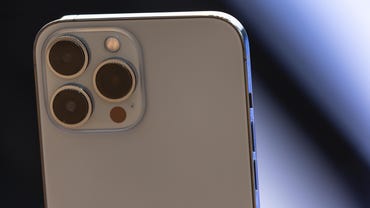
Display: 6.7 inches (2778 x 1284-pixel resolution) 120hz variable refresh rate | CPU: Apple A15 Bionic | RAM: 6GB | Internal storage: 128GB+ storage | Rear cameras: 12MP f/1.5 wide-angle, 12MP f/2.8 telephoto, and 12MP f/1.8 ultrawide cameras | Front camera: 12MP f/2.2 camera | Weight: 240g | Battery capacity: 4352mAh
From the outside, the iPhone 13 Pro Max looks almost identical to its direct predecessor. However, as is often the case with Apple’s flagship, the real improvements all happen behind or, in this case, within the display. The iPhone 13 line Pro is the first to support the company’s ProMotion technology, which not only bumps the maximum refresh rate up to 120hz, but also supports variable refresh rates as low as 10hz for static images. The result is a display that just about always looks buttery smooth without becoming a battery hog.
Read our full review: Apple iPhone 13 Pro Max
The 13 Pro Max is also the best venue for Apple’s new “Cinematic Mode,” a 1080p, 30fps video capture mode that supports things like rack focus and other cinematographer tricks that would have required an expensive standalone camera just a few years ago.
Pros:
- ProMotion display offers noticeably smoother movement over standard 60hz displays
- New computational photography trickery allows for rack focus, filters, and more
- Smaller FaceID “notch” than iPhone 12 line
- New Macro camera can capture images as close as 2cm away
Cons:
- Another year of near-identical external looks
- Apple’s continued reliance on the proprietary lightning connector
Samsung Galaxy Z Fold 3
Best 5G foldable phone
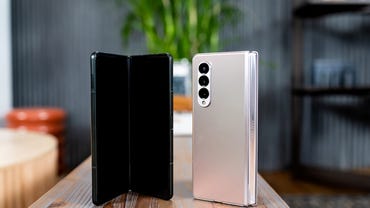
External Display: 6.2 inches (2260 x 832-pixel resolution) 120hz refresh rate | Internal Display: 7.6 inches (2208 x 1768-pixel resolution) flexible | CPU: Qualcomm Snapdragon 888 | RAM: 12GB | Internal storage: 256GB storage | Rear cameras: 12MP f/1.8 wide-angle, 12MP f/2.4 telephoto, and 12MP f/2.2 ultrawide cameras | Front cameras: 4MP f/1.8 under display camera and 10MP f/2.2 cover camera | Weight: 271g | Battery capacity: 4400mAh
The Galaxy Z Fold 3 is Samsung’s latest crack at phone/tablet foldable form factor, and by far its best yet. The device’s bleeding edge internal components live within a case that, perhaps for the first time, seems designed to last for the long haul. Improvements from its predecessor include an outer display that would look at home on any flagship smartphone, a better and more enclosed hinge system, and Samsung’s first under-display camera on a foldable.
Read our full review: Samsung Galaxy Z Fold 3
While the hardware on Samsung’s foldables continues to improve, its pricing remains quite lofty, albeit down a bit since last year. Within the next few years, phone makers are likely to start targeting the mid-market with flexible display devices. But, at least for now, Samsung is firmly aiming its Galaxy Z Fold 3 at the top-end smartphone aficionado that wants the latest internals positioned behind one of the most impressive display combos we’ve ever seen on a smartphone.
Pros:
- Top-end CPU and memory specs
- Vastly improved external display lets you leave the device folded for quick looks
- 7.6-inch internal display makes a legitimate case for using it as a productivity device
- One of the best hinges we’ve seen on a foldable
Cons:
- Still almost twice as much as many other flagships
- Internal creasing on display is improved, but still noticeable
- Behind display camera produces mixed results.
Google Pixel 6 Pro
Best 5G Android phone
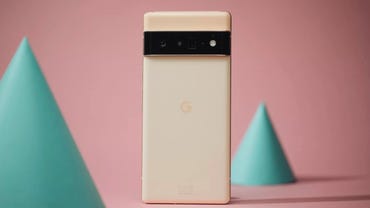
Display: 6.7 inches (3120 x 1440-pixel resolution) 120hz refresh rate | CPU: Google Tensor | RAM: 12GB | Internal storage: 128GB+ storage | Rear cameras: 50MP f/1.85 wide-angle and 48MP f/3.5 telephoto| Front camera: 11MP f/2.2 camera | Weight: 210g | Battery capacity: 4905mAh
For its sixth Pixel generation, Google looked back to its similarly numbered Nexus 6p for inspiration, bringing back the “visor” camera bump that runs all the way across the back of the device. Not only does this provide a more stable resting position when the phone is set down, but it provides ample room for the upgraded 50MP main shooter and 48MP telephoto lens. When combined with Google’s consistently impressive on-device image processing software, they can provide some of the best results we’ve seen from any smartphone camera available today.
Read our full review: Google Pixel 6 Pro
The Pixel 6 line also represents the point when Google joined Apple in basing its flagship smartphone around its own silicon. The Tensor chip provides not only faster processing but the same battery life benefits other companies have already enjoyed when being able to optimize their own chips for their own hardware and software.
Pros:
- Hardware is optimized across the board thanks to Google’s first Tensor chip
- New cameras finally combine Google’s excellent image processing with big MP numbers
- $899 MSRP is impressively low for the included components
Cons:
- No charger in the box
- Some reports of slow fingerprint reader responses
OnePlus 10 Pro
Best value 5G phone
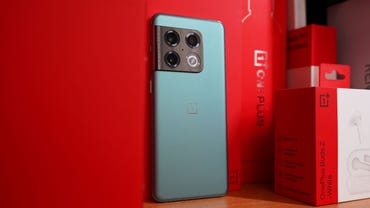
Display: 6.7 inches (3,216 x 1,440-pixel resolution) 120Hz AMOLED | CPU: Qualcomm Snapdragon 8 Gen 1 | RAM: 8GB/12GB LPDDR5 | Internal Storage: 128GB/256GB | Rear cameras: 48MP wide-angle, 50MP ultra-wide angle (150˚), 8MP telephoto (3.3x optical zoom, OIS) | Front camera: 32MP f/2.2 camera | Weight: 200.5g
OnePlus used to be the “flagship killer” brand but has since evolved into higher-priced flagships directly challenging the likes of Samsung and Apple. Compared to Samsung, OnePlus offers an experience that is free from ads and bloatware while also now providing some interesting features such as reverse wireless charging and adaptive 120Hz displays.
The OnePlus 10 Pro is priced in a much more competitive range than last year. At $899, the device is in-line with Google’s flagship, the Pixel 6 Pro, and undercuts Samsung’s S22 Plus and Ultra handsets. Still, OnePlus has managed to cram in specs that go tit for tat with the more expensive rivals.
See the full review: OnePlus 10 Pro review
We’ve hit year two of the brand’s partnership with Swedish camera-maker Hasselblad and the latest update comes in the form of the 50-megapixel ultra-wide lens. With it, you can capture as wide as 150-degrees of imagery, which makes the OnePlus 10 Pro a stellar pick for landscape photography. Additionally, photos and videos look true-to-life thanks to the natural color-tuning by Hasselblad.
One area that OnePlus leads the pack in is the charging capability of its phones. SuperVOOC 65 support and Warp Charge Wireless 50 support are provided in the OnePlus 10 Pro. This means you can charge up your phone from 1% to 100% in just 29 minutes. The wireless charging even achieves this charging performance in 43 minutes, which is faster than wired charging of most other phones. In countries outside of the US, the OnePlus 10 Pro offers a whooping 80W charging speed.
Pros:
- Performance parity with bigger name flagships at reduced prices
- Nearly stock Android build with actually useful tweaks
- Some of the fastest wired and wireless charging speeds around
Cons:
- Storage and RAM configuration is limited to 8GB/128GB in the US
- Hasselblad influence is still limited to software
- Software experience is ever-changing
OnePlus Nord N200 5G
Best sub-$300 5G phone
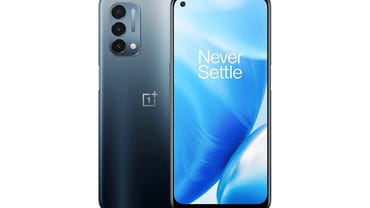
Display: 6.49 inches (2,400 x 1,080-pixel resolution) 90Hz IPS LCD | CPU: Qualcomm Snapdragon 480 | RAM: 4GB | Internal Storage: 64GB | Rear cameras: 13MP rear f/2.2 ultrawide, 2MP f/2.4 macro, and 2MP f/2.4 monochrome| Front camera: 16MP f/2.05 camera | Weight: 189g | Dust/water resistance: none
The OnePlus Nord N200 5G comes from the company’s mid-range Nord line of devices. Although OnePlus first few generations stuck exclusively to the concept of making smartphones that could compete with big-name flagships at mid-range prices, the company’s more recent offerings have grown well into the “premium smartphone” price range. It’s latest flagship, the OnePlus 10 Pro, continued this trend by launching at $899.
Although the OnePlus 10 Pro’s current price puts it out of this list’s purview, the N200 5G comes reasonably close to its hardware specs with the same screen size and resolution (albeit at a lower 90Hz refresh rate), a Qualcomm Snapdragon Series chipset, and a very similar front-facing camera. Some concessions are, of course, included in the lower resolution main rear shooter and the halved RAM and internal storage specs. However, when considering that you could buy a three of these, with some change left over, for the same price as the OnePlus 10 Pro, those moderate downgrades might start mattering a lot less.
Pros:
- Cheapest option on the list
- Same screen resolution as much pricier flagships
- Side-mounted fingerprint sensor is built into power button for fast unlocks
Cons:
- Rear camera array won’t win any awards
- No mmWave 5G support if you’re on Verizon
What is the best 5G phone?
The Apple iPhone 13 Pro Max is the best 5G phone. We analyzed multiple specifications, including CPU, storage, display, price, camera, battery, and more to find the best 5G phone.
How did we choose these smartphones?
The process to make our smartphone selections includes testing the phones for weeks, reading reviews from other websites and publications, researching reviewer guides and manufacturer websites, talking with colleagues and other users who have hands-on experience with the smartphones, and then selecting the best from all of the available choices.
Over the past year, we tested phones from Google, Samsung, Apple, OnePlus, and several others. As newer models are released, we spend a diligent amount of time testing, analyzing, and comparing devices to the competition and their predecessors.
Should I upgrade to a 5G phone?
While 5G integration has been through years of making, the adaptation of the latest cellular network is still in development, with many areas in the world lacking the antennas to support it. That said, there is no downside to not buying a phone that is 5G compatible right now, especially if you plan on using it for the next three or more years. The availability of 5G compatible phones is more extensive than ever (as this list proves) and the chances of your next phone supporting the network are high.
Check the 5G availability in your area below:
It’s important to know that you must be enrolled in a 5G data plan with your local carrier, whether it’s T-Mobile, AT&T, or Verizon, in order to take advantage of the faster speeds. ZDNet’s Jason Cipriani has compiled a helpful list comparing the 5G data plans from all major carriers in the US.
5G networks explained
In the US, we have low-band, mid-band, and high-band wavelength spectrums, with some carriers supporting multiple bands.
The high-band spectrum is composed of short waves that cover small areas with poor ability to penetrate buildings or pass through objects. However, it is the fastest network technology and one that is talked about the most by Qualcomm since it uses Qualcomm mmWave modems to function.
These high-band networks are designed for cities or dense urban areas since they have greater bandwidth and limited range. Verizon’s 5G Ultra Wideband is a high-band spectrum network. AT&T and T-Mobile also support mmWave in 2021, with T-Mobile focusing on low-band for nationwide coverage with mmWave focusing on dense urban areas. mmWave is the most limited in phones, so you have to confirm the presence of radios to support mmWave in the phone you intend to purchase.
Mid-band spectrum networks balance speed and range, but much of this bandwidth is already being used, so it has limited growth opportunities. Sprint used the mid-band spectrum, 2.5GHz, and now that Sprint is a part of T-Mobile, customers will be able to take advantage of this spectrum, as well.
T-Mobile is the primary advocate for the low-band spectrum and was the first to roll it out across the country. All major carriers support low-band 5G, and when you see a phone with 5G on the box, the default network is low-band. The low-band network has a frequency of 600 MHz and is designed for extended coverage with penetration through buildings and obstacles. It is not as fast as mmWave 5G, but current tests show you can expect faster speeds than LTE and much further range. During this time of coronavirus, the low-band spectrum may be more useful as people work inside.






